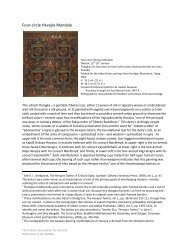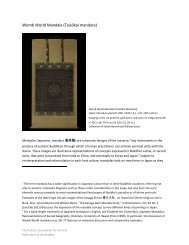Reflections of the Buddha - The Pulitzer Foundation for the Arts
Reflections of the Buddha - The Pulitzer Foundation for the Arts
Reflections of the Buddha - The Pulitzer Foundation for the Arts
Create successful ePaper yourself
Turn your PDF publications into a flip-book with our unique Google optimized e-Paper software.
Main Gallery<br />
<strong>Buddha</strong> Śākyamuni<br />
After <strong>the</strong> death <strong>of</strong> Śākyamuni in <strong>the</strong> fifth century BCE, his followers disseminated his teachings throughout India.<br />
Yet it was not until <strong>the</strong> first century BCE that <strong>the</strong> image <strong>of</strong> Śākyamuni appeared in art. As his image spread to<br />
o<strong>the</strong>r countries and cultures, regional differences appeared, while certain aspects remained consistent: he wears<br />
a monk’s robe, he has an usnīsa, and his earlobes are distended and unadorned (signs <strong>of</strong> renounced wealth). Each<br />
<strong>of</strong> <strong>the</strong> sculptures in this gallery—with <strong>the</strong> possible exception <strong>of</strong> <strong>the</strong> Indian Torso <strong>of</strong> a <strong>Buddha</strong>—was once colorfully<br />
painted.<br />
5. A Scene from <strong>the</strong> Life <strong>of</strong> <strong>the</strong> <strong>Buddha</strong>, late 2nd<br />
or early 3rd century<br />
Pakistan, ancient Gandhāra region;<br />
Kushan period, 1st century BCE – 3rd<br />
century CE; phyllite; 22½ x 37 x 3½<br />
in.; <strong>The</strong> Nelson-Atkins Museum <strong>of</strong> Art,<br />
Kansas City, Missouri, Purchase: William Rockhill Nelson Trust,<br />
55-105<br />
Made <strong>for</strong> a set <strong>of</strong> narrative reliefs <strong>of</strong> <strong>the</strong> <strong>Buddha</strong>’s life,<br />
this panel probably depicts followers greeting Śākyamuni<br />
as he traveled through India teaching <strong>the</strong> Dharma, <strong>the</strong><br />
essence <strong>of</strong> phenomena, or <strong>the</strong> law that governs things.<br />
An artist from a Greco-Buddhist workshop carved it in<br />
Gandhāra, a crossroad on <strong>the</strong> main trade route linking<br />
Asia with <strong>the</strong> Roman Empire.<br />
6. Torso <strong>of</strong> a <strong>Buddha</strong>, 5th century<br />
India, Uttar Pradesh, Mathurā; Gupta period,<br />
320 – 647; mottled red sandstone;<br />
44½ x 21½ x 8½ in.; <strong>The</strong> Nelson-Atkins<br />
Museum <strong>of</strong> Art, Kansas City, Missouri,<br />
Purchase: William Rockhill Nelson Trust,<br />
45-15<br />
This sculpture is carved from mottled red<br />
sandstone, <strong>the</strong> local stone <strong>of</strong> Mathurā, a dynamic and<br />
prosperous region where Buddhist art flourished between<br />
about 319 and 500. <strong>The</strong> folds <strong>of</strong> Śākyamuni’s robe cascade<br />
down in rings, creating a sense <strong>of</strong> serenity and<br />
equilibrium.<br />
7. <strong>The</strong> Monk Ananda (Anantuo), 9th century<br />
China, Tang dynasty, 618 – 907; limestone;<br />
64� x 16 x 8¾ in.; <strong>The</strong> Minneapolis Institute<br />
<strong>of</strong> <strong>Arts</strong>, Gift <strong>of</strong> Ruth and Bruce Dayton, 98.166<br />
Ananda, cousin <strong>of</strong> Śākyamuni, became one<br />
<strong>of</strong> his chief disciples, helping found <strong>the</strong><br />
San� gha, or <strong>the</strong> monastic order <strong>of</strong> men and<br />
women. This sculpture belonged to a<br />
grouping in a cave sanctuary, where <strong>the</strong> Ananda figure<br />
stood next to <strong>the</strong> central image <strong>of</strong> Śākyamuni.<br />
41<br />
8. Head <strong>of</strong> <strong>Buddha</strong> Śākyamuni, 4th century<br />
Afghanistan, ancient Gandhāra region,<br />
probably Hadda; stucco with traces <strong>of</strong> pigment;<br />
18 x 10½ x 9¾ in.; Saint Louis Art<br />
Museum, Museum Purchase, 43:1931<br />
This stucco head likely capped a clay<br />
body, which was part <strong>of</strong> a sculptural<br />
group attached to a wall, probably in<br />
Hadda, one <strong>of</strong> <strong>the</strong> largest Buddhist centers in<br />
Afghanistan.<br />
9. Standing <strong>Buddha</strong> Śākyamuni (Shijiamouni),<br />
late 6th century<br />
China, Nor<strong>the</strong>rn Qi dynasty, 550 – 577, or<br />
Sui dynasty, 581 – 618; marble with traces<br />
<strong>of</strong> pigment; 63¾ x 18 x 9 in.; Saint Louis Art<br />
Museum, Museum Purchase, 182:1919<br />
This sculpture presents a lotus bud<br />
carved between Śākyamuni’s feet and an<br />
honorific tassel in <strong>the</strong> <strong>for</strong>m <strong>of</strong> a lotus blossom near his<br />
shoulder. Since <strong>the</strong> lotus has roots in mud, a stem that<br />
extends up through water, and a flower that blossoms in<br />
<strong>the</strong> sun, its growth, <strong>for</strong> Buddhists, signifies <strong>the</strong> exit from<br />
<strong>the</strong> mud <strong>of</strong> samsāra into <strong>the</strong> radiance <strong>of</strong> Nirvāna.<br />
10. Sea <strong>of</strong> <strong>Buddha</strong>, 1995, Hiroshi Sugimoto<br />
Japanese, born 1948; gelatin<br />
silver prints, triptych,<br />
negative numbers 001, 002, 003;<br />
each: 47 x 58¾ in.; private<br />
collection<br />
With this series, Sugimoto<br />
photographed <strong>the</strong> interior <strong>of</strong><br />
Sanjūsangen-dō, a twelfth-century Buddhist temple in<br />
Kyoto with 1,001 life-size sculptures <strong>of</strong> <strong>the</strong> bodhisattva <strong>of</strong><br />
compassion, Avalokiteśvara, standing multiple rows deep.<br />
Each one depicted here has <strong>for</strong>ty arms, with <strong>the</strong> power to<br />
save twenty-five worlds. Sugimoto wanted to capture<br />
<strong>the</strong>ir “splendor . . . glistening in <strong>the</strong> light <strong>of</strong> <strong>the</strong> morning<br />
sun rising over <strong>the</strong> Higashiyama hills as <strong>the</strong> Kyoto aristocracy<br />
might have seen in <strong>the</strong> Heian period.”




